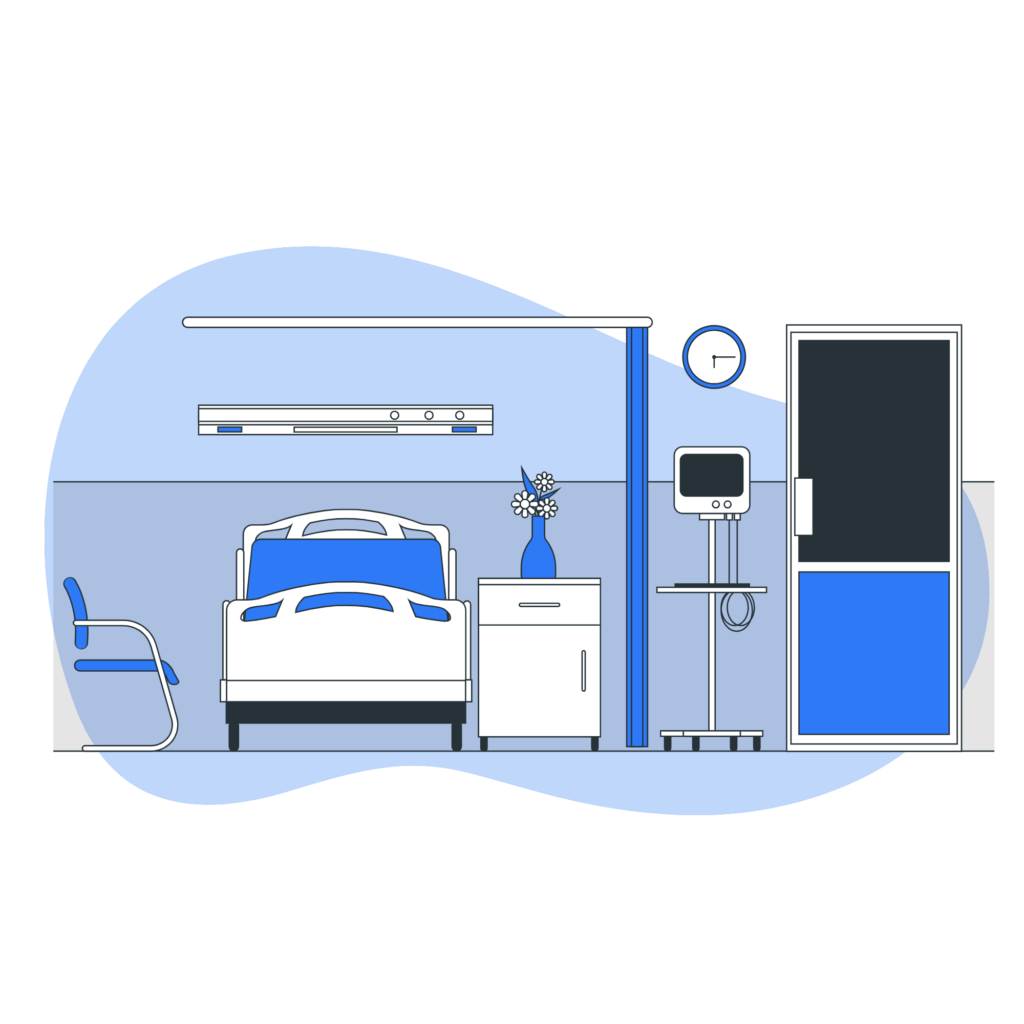Workforce challenges pose the greatest threat to healthcare organizations in 2024. The demand for healthcare services has surged, while an increasing number of healthcare professionals are exiting the industry. Consequently, the healthcare workforce of today is beset by shortages and high turnover rates, leaving many healthcare providers struggling to find and recruit qualified candidates.
In this article, we delve into the reasons behind the difficulty in filling certain healthcare roles and discuss key strategies for attracting and retaining healthcare talent.
Analyzing the Current State of Healthcare Staffing
Healthcare recruitment today is fiercely competitive, presenting a significant challenge for recruiters and sourcing professionals to stay ahead. Healthcare recruiters, on average, are juggling 61 open positions simultaneously. It takes about 49 days to fill a role in healthcare, compared to the United States industry average of just 36 days.
To reduce the time it takes to fill positions without compromising the quality of care, healthcare organizations must shift from a reactive approach to a more proactive strategy in sourcing top talent. By streamlining recruitment processes and workflows and adopting contemporary candidate sourcing techniques, healthcare providers can improve their time-to-fill metrics, even for the most challenging positions.
Addressing High Demand and Low Supply in Critical Healthcare Roles
In the healthcare sector, positions that are typically hard to fill include roles such as registered nurses, nurse practitioners, general practitioners, physical therapists, and psychiatrists. Additionally, staffing challenges are prevalent in specialty areas like geriatrics, rheumatology, and various surgical specializations.
These healthcare roles are challenging to fill due to a scarcity of qualified professionals, demanding job responsibilities, and the significant experience and specialization these positions require. Moreover, the inclusion of shift work in these roles can affect work-life balance, deterring some qualified candidates. The time-to-fill issue is further exacerbated by organizational workflow inefficiencies, a lack of recruitment data, and insufficient technological support for contemporary recruitment methods.
Neglecting a strategic approach to talent management, particularly focusing on retention during the hiring process, can trap health systems in a relentless cycle of employee turnover.
While many physicians retire due to age, an increasing number are opting for early retirement, dissatisfied with the current state of the U.S. health system. Alarmingly, a significant number of young or mid-career physicians plan to leave their organizations within two years. Addressing the ongoing physician shortage in medicine, therefore, involves not just recruitment but also understanding and responding to doctors’ intentions to leave an organization, possibly requiring more intelligent use of technology.
A survey conducted by the AMA found that between 2021 and 2022 40% of physicians were considering leaving their current organization within two years, whether they had a moderate interest in leaving or were definite about their decision.
Interestingly, the same survey showed that 46% of physicians felt valued by their organization to a significant or moderate extent. In contrast, 18% did not feel valued at all by their organization, highlighting a crucial area for improvement in physician retention strategies.

Tackling the National Healthcare Staffing Crisis in Rural Areas
Attracting and retaining skilled healthcare workers is a particularly daunting challenge in rural settings. Between 2010 and 2021, at least 136 rural hospitals and health systems closed, with over 40% of rural hospitals operating at negative profit margins. The pandemic’s initial year saw the closure of 19 rural hospitals, a trend that has slowed since then, with only six closures following.
However, experts warn that these historic lows may be misleading. In the decade before 2020, the financial margins of rural hospitals were declining, resulting in more than 130 closures. The COVID-19 pandemic intensified the existing issues of limited staff and capacity in these hospitals. Pandemic relief funds did provide billions of dollars to alleviate the rising costs faced by rural hospitals.
Despite this assistance, rural hospitals continue to close at unprecedented rates, and primary care physicians (PCPs) – who are essential for routine checkups and care – are facing additional challenges. In 2023, a report by the Health Resources and Services Administration revealed that 65% of rural areas experienced a shortage of primary care physicians. This is significant considering that more than 15% of Americans, roughly 46 million people, reside in rural areas, but only 10% of doctors practice in these communities, with many being primary care and family physicians.
A 2021 study by the Association of American Medical Colleges (AAMC) projected that the United States could face a shortage of between 37,800 and 124,000 physicians by 2034. The study further noted that if rural residents had the same healthcare access as urban dwellers, rural areas would require an additional 180,000 doctors.
Healthcare professionals believe that the scarcity of PCPs can escalate costs in other healthcare areas and deteriorate overall patient outcomes. For instance, without access to a PCP, a person with strep throat might resort to visiting a hospital emergency room, which incurs significantly higher costs than other treatment options.
Forbes has presented a grim forecast with staggering figures:
“Healthcare staffing shortages are expected to persist into 2024, with a study projecting that over 6.5 million U.S. healthcare professionals will permanently exit their roles by 2026, while only 1.9 million are anticipated to fill these vacancies. This is projected to result in a national shortfall of more than 4 million healthcare workers.”

Four Innovative Strategies to Enhance Your Healthcare Talent Pipeline
The American Hospital Association (AHA) suggests several innovative approaches that could be a game-changer:
- Productive Partnerships
In Baltimore County, a partnership between the University of Maryland St. Joseph Medical Center (UMSJMC) and the Community College of Baltimore County (CCBC) is connecting residents from historically underserved communities to in-demand nursing positions. This initiative includes the Public Health Pathways Program, which offers 30 scholarships covering tuition and fees for the CCBC’s Certified Nursing Assistant program, along with a $1,000 monthly stipend to support participants’ various needs. Graduates are guaranteed employment with UMSJMC and have the opportunity to continue their education towards becoming Licensed Practical Nurses (LPNs), supported by comprehensive mentorship and tutoring.
- Reconfigured Clinical Training
Addressing the shortage of nurse preceptors, Novant Health in Winston-Salem, North Carolina, has introduced a Clinical Teaching Associate program, enabling nurses to serve as adjunct faculty. The University of Maryland Medical System’s Academy of Clinical Essentials (ACE) pairs nursing students with clinical nurses for hands-on experience. This program enhances the recruitment pipeline and enriches the ranks of nurse educators by enabling registered nurses to serve as clinical instructors while maintaining their hospital practice.
- Mobility
Old Dominion University’s School of Nursing in Southampton County, Virginia, has tackled healthcare disparities and preceptor shortages by launching a mobile health clinic. This innovative approach allows advanced practice students to provide a range of healthcare services directly to the community, potentially encouraging them to continue practicing in these rural areas.
- Engaged Youth
Grady Health in Atlanta introduced the Teen Experience and Leadership Program, enabling high school students to shadow professionals across various hospital departments. This program, which attracted a diverse group of students from different educational backgrounds, not only exposes young people to healthcare careers but also fosters compassion for patients and a deeper understanding of the hospital’s role in the community.
These strategies represent a comprehensive approach to addressing healthcare staffing challenges, combining education, hands-on experience, community engagement, and innovative training models.

Strategies to Overcome Healthcare Workforce Shortages in 2024
Administrative tasks in healthcare, often tedious and time-consuming, can place a significant burden on staff. These tasks, while necessary, can divert attention from more critical activities like revenue cycle management (RCM), which requires a personal touch and has a direct impact on the bottom line.
Many health systems are grappling with modest or weak operating margins, leading to a growing interest in outsourcing, as projected by Deloitte. As cost pressures mount, hospitals are increasingly considering outsourcing functions such as RCM, credentialing, billing, and finance.
Although the financial health of most systems has improved compared to last year, many hospitals still operate with margins barely above the break-even point. Financial analysts, including those at Fitch Ratings and S&P Global Ratings, foresee only modest improvements in 2024, with nonprofit hospitals likely continuing to face financial constraints.
Health systems are thus evaluating which functions they perform efficiently in-house versus those that could be more cost-effectively outsourced. Historically, the healthcare industry has been less inclined towards outsourcing business processes compared to other sectors, but this trend is changing.
Concurrently, there is an increasing emphasis within hospitals and health systems on the recruitment and retention of frontline healthcare workers, including doctors, nurses, and other direct patient care staff. By outsourcing some administrative tasks, health systems can potentially reallocate resources to invest more significantly in their clinical workforce, enhancing patient care and operational efficiency.

Expert Solutions for Healthcare Licensing and Staffing Efficiency
As healthcare organizations grapple with the challenges of finding and retaining qualified professionals, the efficiency and accuracy of licensing processes can significantly impact operational success.
Our medical licensing service provides a streamlined, expert-driven approach to this essential aspect. We specialize in comprehensive licensing solutions for a wide range of healthcare professionals, including MDs, DOs, PA-Cs, RNs, APRNs, and more. Our expertise extends to facilitating both initial licensure and the often-overlooked but crucial aspect of license renewal.
Key features of our service include:
Auto-Renewal System: Our service offers 24/7 monitoring of your license status, ensuring that you remain compliant with state-specific Continuing Education (CE) requirements. With our auto-renewal feature, your license is renewed efficiently before its expiration, eliminating the risk of lapses that could disrupt your staffing flow.
Customized Support for Diverse Healthcare Roles: Understanding the unique requirements of different healthcare professions, our service tailors its approach to meet the specific needs of each role, ensuring a seamless licensing process for all staff members.
In a highly competitive healthcare market, our licensing service acts as a strategic partner, aiding in the recruitment and retention of top talent. By ensuring a smooth licensing process, we help you maintain a stable, compliant, and highly qualified workforce, which is essential for delivering quality healthcare services.
By entrusting the licensing process to our expert team, healthcare organizations can free up valuable internal resources. This shift allows your team to focus on core functions, such as improving patient care and enhancing revenue cycle management (RCM), thus contributing positively to your bottom line.
Don’t let administrative complexities hinder the potential of your healthcare organization. Join the ranks of leading healthcare organizations who have transformed their operations with our services. Contact us now to learn how we can tailor our solutions to meet your specific needs and empower your team to achieve excellence in healthcare delivery.
-
What are the primary causes of healthcare staffing shortages in 2024?
The primary causes of staffing shortages in healthcare in 2024 are a surge in demand for healthcare services and an increasing number of healthcare professionals leaving the industry. Factors contributing to this include the aging population, burnout among healthcare workers, and the evolving expectations of work-life balance in the healthcare sector. Additionally, the time-to-fill for healthcare positions is longer than in other industries, exacerbating the shortage. -
How can healthcare organizations effectively address hard-to-staff roles?
Healthcare organizations can address hard-to-staff roles by adopting proactive talent sourcing strategies, optimizing recruitment processes, and leveraging modern recruitment technologies. Focusing on specialties like registered nurses, general practitioners, and psychiatrists, organizations need to streamline their hiring processes, provide competitive compensation, and offer work-life balance to attract qualified candidates. Additionally, implementing retention strategies during the hiring process and focusing on employee engagement are crucial for reducing turnover. -
What innovative strategies are being used to strengthen the healthcare talent pipeline?
Innovative strategies to strengthen the healthcare talent pipeline include forming productive partnerships, reconfiguring clinical training, implementing mobile health clinics in rural areas, and engaging youth through experience and leadership programs. These initiatives aim to make healthcare careers more accessible, provide hands-on training opportunities, and ensure a continuous influx of skilled professionals into the healthcare sector.



